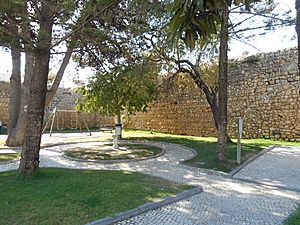Alvor massacre facts for kids
The Alvor massacre was a terrible event that happened in June 1189. It was during the Third Crusade, a time when Christian armies from Europe tried to take back lands in the Middle East. A group of crusaders from places like the Holy Roman Empire (which was a big empire in central Europe), Denmark, and Flanders (a region in modern-day Belgium) attacked the castle of Alvor. Alvor was a town in the Algarve region of what is now Portugal. At that time, it was part of the Almohad Caliphate, a Muslim empire.
The crusaders stormed the castle and killed about 5,600 people. It's not completely clear how this event fits into the Portuguese Reconquista, which was the long period when Christian kingdoms in the Iberian Peninsula (Spain and Portugal) took back land from Muslim rule. However, it seems it was part of a plan by King Sancho I of Portugal, who started a siege of Silves (another nearby town) just a month later.
How We Know About It
Historians know about the Alvor massacre from several old writings. One important source is called the Account of the Seaborne Journey, written by a crusader from northern Germany. Another old book that mentions it is the Royal Chronicle of Cologne.
An Arabic source, the Bayān al-mughrib by Ibn ʿIdhārī, also talks about Alvor being lost. It calls Alvor "the port" and says the crusaders "dealt death to all that were in it, great and small, men and women." Some later historical accounts mixed up the attack on Alvor with the capture of Silves, another important city.
The Crusader Journey
In February 1189, a large fleet of more than fifty ships set sail from Frisia, a region in Europe. These ships carried around 12,000 men. At the mouth of the Rhine river, they met up with another fleet. This second group included crusaders from the Rhineland, Holland, and Flanders.
From there, the combined fleet sailed to Dartmouth in England. More ships from England and Flanders joined them. One old record says the fleet had 55 ships. It included people from Denmark, Flanders, Frisia, and cities like Cologne and Liège.
The Royal Chronicle says the fleet left during Lent, a Christian religious period. Ten days later, they stopped in Galicia, a region in Spain. By then, the fleet had 60 ships and "10,000 fighting men and more."
The crusaders tried to visit the shrine of Saint James in Compostela. But a rumor spread that they wanted to steal the saint's relics (holy objects). This led to fighting between the crusaders and the townspeople, and some people died on both sides. Eventually, wise people stepped in, and the crusaders agreed to go back to their ships.
After the attack on Alvor, the Royal Chronicle also mentions that the crusaders "captured endless amounts of silver and gold." After the town was sacked, the men from Cologne decided to stay in Portugal. The rest of the expedition continued sailing east. They eventually joined the big siege of Acre in the Middle East.
The leaders of the fleet that attacked Alvor are not named in any of the old writings. It seems that most of the crusaders were ordinary people, not famous knights or nobles. The attack happened sometime in June 1189. It's not clear how long it took to capture Alvor, but it was probably stormed quickly, meaning they attacked suddenly rather than having a long siege. After Silves was captured, King Sancho I gave Alvor to the monastery of Santa Cruz.
Alvor's Place in the Reconquista
No old source directly says that the crusaders who attacked Alvor were working with Portugal. However, it's very likely they were. The fleet was in Lisbon (the capital of Portugal) before the attack. Also, some Portuguese galleys (ships) went with them as far as the Straits of Gibraltar. The attack on Alvor was also very helpful for King Sancho I's plan to attack Silves.
The massacre at Alvor was unusual for the Portuguese Reconquista. Usually, the policy was to encourage Muslim people to stay in the conquered lands. This was so they could continue farming and pay taxes to the king. The widespread killing at Alvor shocked people at the time.
The attack on Alvor is not mentioned in many medieval Portuguese history books. It might have even been left out on purpose. For example, in the Chronicle of 1419, which talks about King Sancho I's rule, the capture of Silves is described in detail, but Alvor is not mentioned at all.
Alvor was later taken back by the Almohads during their campaign in 1191.
Images for kids



